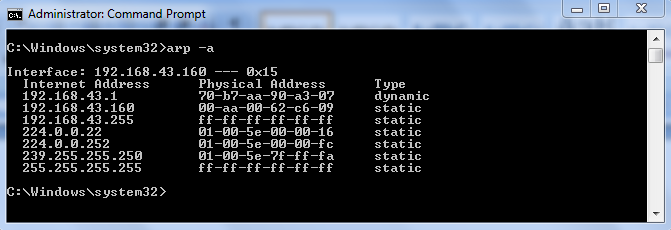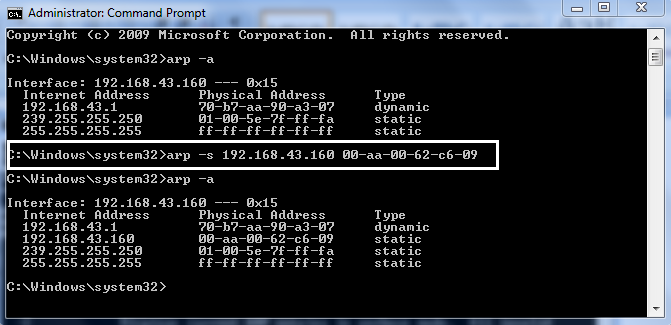Tutorial
Physical Layer
Data Link layer
Network Layer
Routing Algorithm
Transport Layer
Application Layer
Network Security
Misc
- Router
- OSI vs TCP/IP
- TCP vs UDP
- Transmission Control Protocol
- TCP port
- IPv4 vs IPv6
- ARP Packet Format
- ARP Table
- Working of ARP
- FTP Client
- FTP Commands
- FTP Server
- I2C Protocol
- Sliding Window Protocol
- SPI Protocol
- IP
- ARP Commands
- ARP
- Address Resolution Protocol
- ARP and its types
- TCP Retransmission
- CAN protocol
- HTTP Status Codes
- HTTP vs HTTPS
- RIP Protocol
- UDP Protocol
- ICMP Protocol
- MQTT protocol
- OSPF Protocol
- Stop and Wait Protocol
- IMAP Protocol
- POP Protocol
- CIFS
- DAS
- DIMM
- iSCSI
- NAS (Network Attached Storage)
- NFS
- NVMe
- SAN
- Border Gateway Protocol
- Go-Back-N ARQ
- RJ Cable
- Difference between Connection-Oriented and Connectionless Service
- CDMA vs. GSM
- What is MAC Address
- Modem vs. Router
- Switch Vs. Router
- USB 2.0 vs 3.0
- Difference between CSMA CA and CSMA CD
- Multiple access protocol- ALOHA, CSMA, CSMA/CA and CSMA/CD
- URI vs URL
- IMAP vs. POP3
- SSH Meaning| SSH Protocol
- UTP vs STP
- Status Code 400
- MIME Protocol
- IP address
- proxy server
- How to set up and use a proxy server
- network security
- WWW is based on which model
- Proxy Server List
- Fundamentals of Computer Networking
- IP Address Format and Table
- Bus topology and Ring topology
- Bus topology and Star topology
- Circuit Switching and Packet switching?
- Difference between star and ring topology
- Difference between Router and Bridge
- TCP Connection Termination
- Image Steganography
- Network Neutrality
- Onion Routing
- Adaptive security appliance (ASA) features
- Relabel-to-front Algorithm
- Types of Server Virtualization in Computer Network
- Access Lists (ACL)
- What is a proxy server and how does it work
- Digital Subscriber Line (DSL)
- Operating system based Virtualization
- Context based Access Control (CBAC)
- Cristian's Algorithm
- Service Set Identifier (SSID)
- Voice over Internet Protocol (VoIP)
- Challenge Response Authentication Mechanism (CRAM)
- Extended Access List
- Li-fi vs. Wi-fi
- Reflexive Access List
- Synchronous Optical Network (SONET)
- Wifi protected access (WPA)
- Wifi Protected Setup (WPS)
- Standard Access List
- Time Access List
- What is 3D Internet
- 4G Mobile Communication Technology
- Types of Wireless Transmission Media
- Best Computer Networking Courses
- Data Representation
- Network Criteria
- Classful vs Classless addressing
- Difference between BOOTP and RARP in Computer Networking
- What is AGP (Accelerated Graphics Port)
- Advantages and Disadvantages of Satellite Communication
- External IP Address
- Asynchronous Transfer Mode (ATM)
- Types of Authentication Protocols
- What is a CISCO Packet Tracer
- BOOTP work
- Subnetting in Computer Networks
- Mesh Topology Advantages and Disadvantages
- Ring Topology Advantages and Disadvantages
- Star Topology Advantages and Disadvantages
- Tree Topology Advantages and Disadvantages
- Zigbee Technology-The smart home protocol
- Network Layer in OSI Model
- Physical Layer in OSI Model
- Data Link Layer in OSI Model
- Internet explorer shortcut keys
- Network Layer Security | SSL Protocols
- Presentation Layer in OSI Model
- Session Layer in OSI Model
- SUBNET MASK
- Transport Layer Security | Secure Socket Layer (SSL) and SSL Architecture
- Functions, Advantages and Disadvantages of Network Layer
- Protocols in Noiseless and Noisy Channel
- Advantages and Disadvantages of Mesh Topology
- Cloud Networking - Managing and Optimizing Cloud-Based Networks
- Collision Domain and Broadcast Domain
- Count to Infinity Problem in Distance Vector Routing
- Difference Between Go-Back-N and Selective Repeat Protocol
- Difference between Stop and Wait, GoBackN, and Selective Repeat
- Network Function Virtualization (NFV): transforming Network Architecture with Virtualized Functions
- Network-Layer Security | IPSec Modes
- Next - Prev Network-Layer Security | IPSec Protocols and Services
- Ping vs Traceroute
- Software Defined Networking (SDN): Benefits and Challenges of Network Virtualization
- Software Defined Networking (SDN) vs. Network Function Virtualization (NFV)
- Virtual Circuits vs Datagram Networks
- BlueSmack Attack in Wireless Networks
- Bluesnarfing Attack in Wireless Networks
- Direct Sequence Spread Spectrum
- Warchalking in Wireless Networks
- WEP (Wired Equivalent Privacy)
- Wireless security encryption
- Wireless Security in an Enterprise
- Quantum Networking
- Network Automation
- Difference between MSS and MTU
- What is MTU
- Mesh Networks: A decentralized and Self-Organizing Approach to Networking
- What is Autonomous System
- What is MSS
- Cyber security & Software security
- Information security & Network security.
- Security Engineer & Security Architect
- Protection Methods for Network Security
- Trusted Systems in Network Security
- What are Authentication Tokens in Network security
- Cookies in Network Security
- Intruders in Network Security
- Network Security Toolkit (NST) in virtual box
- Pivoting-Moving Inside a Network
- Security Environment in Computer Networks
- Voice Biometric technique in Network Security
- Advantages and Disadvantages of Conventional Testing
- Difference between Kerberos and LDAP
- Cyber security and Information Security
- GraphQL Attacks and Security
- Application Layer in OSI Model
- Applications of Remote Sensing
- Seven Layers of IT Security
- What is Ad Hoc TCP
- What is Server Name Indication(SNI)
ARP Table
ARP Table is used to keep the record of the IP address and MAC address of the devices (source and destination device). For the communication between two devices, it is necessary that the IP address and the MAC address of the source and the destination device should be stored in an ARP table. If there is no record in the table, an ARP broadcast is sent by the source to all the devices in a network. All the devices compare their own IP address with the IP address of the destination device. When the IP address of the device matches with each other, that device sent the response, which is then updated in an ARP table. Each host that is connected to the network should have to maintain an ARP table on its own.
Example: Suppose, many devices are connected to a switch. When these devices get connected to the router, the IP addresses of these devices get stored in the cache memory (ARP table). When the device (source) sends an ARP request, the ARP table checks the IP address connected to the device and converts the information into a packet. Then deliver the packet to the appropriate IP address.
Operations in an ARP Table
We can perform many operations in an ARP table such as to display, add and remove ARP entries in the ARP table (ARP cache). To perform these operations, we use an arp command offered by the Windows Operating System.
List and Display ARP entries.
You can display the ARP entries by using the command arp -a. This list of entries is displayed in the terminal according to the interfaces.
Steps for displaying the ARP entries
Step 1: Go to the start menu. Open the command prompt.

Step 2: Type arp -a command in the command prompt or terminal and press enter button. After pressing the enter button, all the ARP entries will display in the command prompt.

Add static ARP entry.
The ARP table also provides a feature that is adding a static ARP entry to the AP table. With the help of this, we can add the IP address and MAC address to the ARP table (ARP cache). These entries will be stored until the computer restarts. The type of these entries will remain static when they are listed in the table.
Steps to add a static ARP entry
To add a static entry, type arp -s command along with the IP address and MAC address in a command prompt and then press enter.
- Syntax: arp -s 192.168.43.160 00-aa-00-62-c6-09
Where, IP address = 192.168.43.160
MAC address = 00-aa-00-62-c6-09

Remove ARP entry
We can also remove the arp entries irrespective of the entry type, such as static and dynamic.
Steps for removing an ARP entry
Step 1: To remove an ARP entry type, the command arp -a. This command will display all the ARP entries with their IP address, MAC address, and the entry type.

Step 2: Now, type the arp -s command along with the IP address, which we want to delete and then press enter. It is necessary that the IP address must be from the listed entries.
- Syntax: arp -d 192.168.43.255

In the above example, we have deleted the entry having IP address 192.168.43.255.
Step 3: To check whether the entry is deleted or not again type arp -a command and press enter key. After pressing enter key, all the entries will be displayed in the command prompt except the deleted one.

In the above figure, the entry having IP address 192.168.43.255 is not present.


